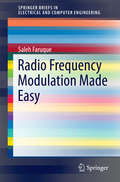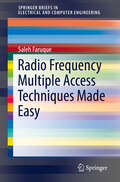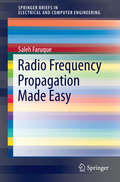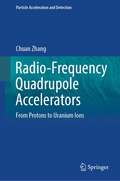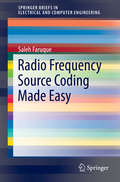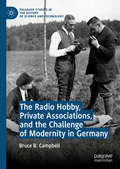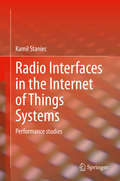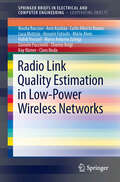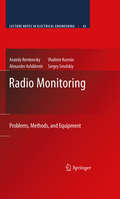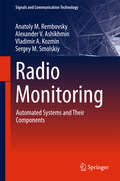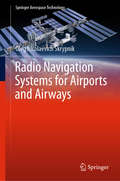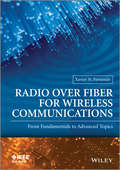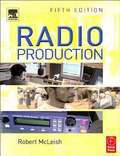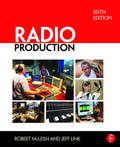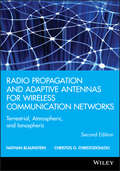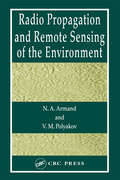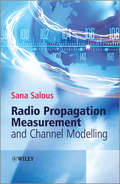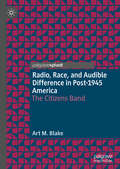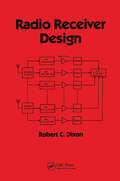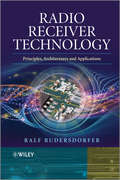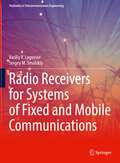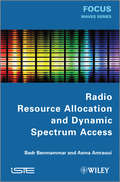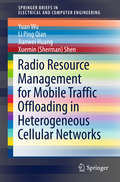- Table View
- List View
Radio Frequency Modulation Made Easy
by Saleh FaruqueThis book introduces Radio Frequency Modulation to a broad audience. The author blends theory and practice to bring readers up-to-date in key concepts, underlying principles and practical applications of wireless communications. The presentation is designed to be easily accessible, minimizing mathematics and maximizing visuals.
Radio Frequency Multiple Access Techniques Made Easy (SpringerBriefs in Electrical and Computer Engineering)
by Saleh FaruqueThis book provides a comprehensive overview of multiple access techniques used in the cellular industry. The usage of multiple access techniques in telecommunications enables many users to share the same spectrum in the frequency domain, time domain, code domain or phase domain. Licenses are given, by the FCC, to operate wireless communication systems over given bands of frequencies, with the smaller bands, (channels), reused to provide services to other users. Thus, bandwidth efficiency is vital, as the speed and size of digital data networks continue to expand. This brief also uses numerous illustrations to bring students up-to-date in the practical applications of multiple access techniques, which can then be put to work in the industry. Primarily, electrical engineering students who study telecommunications, as well as engineers and designers working in wireless communications, would find this book useful.
Radio Frequency Propagation Made Easy
by Saleh FaruqueThis book introduces Radio Frequency Propagation to a broad audience. The author blends theory and practice to bring readers up-to-date in key concepts, underlying principles and practical applications of wireless communications. The presentation is designed to be easily accessible, minimizing mathematics and maximizing visuals.
Radio-Frequency Quadrupole Accelerators: From Protons to Uranium Ions (Particle Acceleration and Detection)
by Chuan ZhangThis book guides readers into the realm of particle accelerators, which have served as indispensable tools for fundamental research, energy development, medical therapy, industrial applications, national security, etc., since 1924. Towards a new generation of high power proton and ion accelerators, challenges often come from space charge effects, which are most pronounced in low-velocity beams. This book focuses on Radio-Frequency Quadrupole (RFQ) accelerators, one of the most popular front-end structures for accelerator facilities, and their beam physics. Uncovering the limitations of the classic design methods, novel approaches to achieve efficient RFQ accelerators with high beam quality will be presented. In addition, new ideas for possible future developments, such as how to realize long RFQs with high performance and how RFQs can be applied for much higher beam-velocities to shorten large-scale accelerators, will be introduced. To provide a general overview of the research and development of RFQs accelerating particle species from protons to uranium ions, this book uses over 10 real examples developed or proposed in the twenty-first century for various facilities of different dimensions (from large scale e.g. a collider to small scale e.g. university experimental setups). With its rich content and comprehensive scope, this book is an invaluable reference for researchers and graduate students interested in RFQ accelerators and the intricacies of space charge physics in low-velocity beams.
Radio Frequency Source Coding Made Easy
by Saleh FaruqueThis book introduces Radio Frequency Source Coding to a broad audience. The author blends theory and practice to bring readers up-to-date in key concepts, underlying principles and practical applications of wireless communications. The presentation is designed to be easily accessible, minimizing mathematics and maximizing visuals.
The Radio Hobby, Private Associations, and the Challenge of Modernity in Germany (Palgrave Studies in the History of Science and Technology)
by Bruce B. CampbellIn the early twentieth century, the magic of radio was new, revolutionary, and poorly understood. A powerful symbol of modernity, radio was a site where individuals wrestled and came to terms with an often frightening wave of new mass technologies. Radio was the object of scientific investigation, but more importantly, it was the domain of tinkerers, “hackers,” citizen scientists, and hobbyists. This book shows how this wild and mysterious technology was appropriated by ordinary individuals in Germany in the first half of the twentieth century as a leisure activity. Clubs and hobby organizations became the locus of this process, providing many of the social structures within which individuals could come to grips with radio, apart from any media institution or government framework. In so doing, this book uncovers the vital but often overlooked social context in which technological revolutions unfold.
Radio in Revolution: Wireless Technology and State Power in Mexico, 1897–1938 (The Mexican Experience)
by J. Justin CastroLong before the Arab Spring and its use of social media demonstrated the potent intersection between technology and revolution, the Mexican Revolution employed wireless technology in the form of radiotelegraphy and radio broadcasting to alter the course of the revolution and influence how political leaders reconstituted the government.Radio in Revolution, an innovative study of early radio technologies and the Mexican Revolution, examines the foundational relationship between electronic wireless technologies, single-party rule, and authoritarian practices in Mexican media. J. Justin Castro bridges the Porfiriato and the Mexican Revolution, discussing the technological continuities and change that set the stage for Lázaro Cárdenas’s famous radio decree calling for the expropriation of foreign oil companies. Not only did the nascent development of radio technology represent a major component in government plans for nation and state building, its interplay with state power in Mexico also transformed it into a crucial component of public communication services, national cohesion, military operations, and intelligence gathering. Castro argues that the revolution had far-reaching ramifications for the development of radio and politics in Mexico and reveals how continued security concerns prompted the revolutionary victors to view radio as a threat even while they embraced it as an essential component of maintaining control.
Radio Interfaces in the Internet of Things Systems: Performance studies
by Kamil StaniecThe book gives a broad overview of the Internet of Things (IoT) concept from various angles. The book provides rationale for: the concept development; its regulatory and technical background associated aspects such as the ambient and edge intelligence; fog computing; capillary networks and machine-type communications; etc. Each of these items is then extended in further respective chapters that deal with technicalities behind them. Chapters: 2-5, 8, 10-11 are addressed to those who seek expository IoT-related information on aspects such as the pathloss calculation, narrowband radio interfaces, radiation masks, spectrum matters, medium access control, and a transmission frame construction. That section ends with an exhaustive description of the six most popular IoT systems: LoRa, Weightless, SigFox, NB-IoT, LTE-M(TC) and EC-GSM IoT. Specialists and network designers may find chapters 6 and 7 interesting where a novel methodology is proposed for testing narrowband IoT systems performance for immunity to electromagnetic interference (EMI) and multipath propagation, both emulated in artificial conditions of the anechoic and the reverberation chamber.
Radio Link Quality Estimation in Low-Power Wireless Networks
by Marco Antonio Zuniga Carlo Alberto Boano Claro Noda Luca Mottola Habib Youssef Hossein Fotouhi Daniele Puccinelli Anis Koubâa Kay Römer Mário Alves Nouha Baccour Thiemo VoigtThis book provides a comprehensive survey on related work for radio link quality estimation, which covers the characteristics of low-power links, the fundamental concepts of link quality estimation in wireless sensor networks, a taxonomy of existing link quality estimators and their performance analysis. It then shows how link quality estimation can be used for designing protocols and mechanisms such as routing and hand-off. The final part is dedicated to radio interference estimation, generation and mitigation.
Radio Monitoring
by Alexander Ashikhmin Vladimir Kozmin Sergey M. Smolskiy Anatoly RembovskyRadio Monitoring: Problems, Methods, and Equipment offers a unified approach to fundamental aspects of Automated Radio Monitoring (ARM). The authors discuss the development, modeling, design, and manufacture of ARM systems. Data from established and recent research are presented and recommendations are made on methods and approaches for solving common problems in ARM. The authors also provide classification and detailed descriptions of modern high-efficient hardware-software ARM equipment, including the equipment for detection, radio direction-finding, parameters measurement and their analysis, and the identification and localization of the electromagnetic field sources. Examples of ARM equipment structure, applications, and software are provided to manage a variety of complicated interference environment in the industrial centers, inside of the buildings, and in the open terrain. This book provides a reference for professionals and researchers interested in deploying ARM technology as a tool for solving problems from radio frequency spectrum usage control.
Radio Monitoring: Problems, Methods And Equipment (Lecture Notes In Electrical Engineering #43)
by Anatoly M. Rembovsky Alexander V. Ashikhmin Vladimir A. Kozmin Sergey M. SmolskiyThis book discusses the architecture of modern automated systems for spectrum monitoring including automation components: technical means for spectrum monitoring, special software and engineering infrastructure. The problems of automated system development for search and localization of unauthorized radio emission sources in open localities, mathematical methods and algorithms for modulation of parameter measurements for wireless communication as well as issues of identification and localization of radio emission sources are considered. Constructive solutions and modern technical means for radio monitoring and their application are given. Numerous examples are described for the implementation of automated systems, digital radio receivers and radio direction-finders, analyzers of parameters for GSM, CDMA, LTE, DVB-T/T2, Wi-Fi, DMR, P25, TETRA and DECT signals. Practical implementations of the described methods are presented in applied software packages and in radio monitoring equipment.
Radio Navigation Systems for Airports and Airways (Springer Aerospace Technology)
by Oleg Nicolaevich SkrypnikThis book highlights the design principles of ground based radio-navigation systems used in solving navigation tasks in the airfield and on air routes. Mathematical correlations are illustrated that describe its operation, peculiarities of disposition, main technical characteristics, generalized structural diagrams as well as the inter-operation with onboard equipment. Examples of building, construction, functional diagrams, and characteristics of Russian made radio-navigation systems are discussed. This book is written for students of electronics and aviation disciplines. It can also be useful for aviation specialists as well as for those interested in air radio-navigation.
Radio over Fiber for Wireless Communications: From Fundamentals to Advanced Topics (Wiley - IEEE)
by Xavier N. FernandoA comprehensive evaluation of Fi-Wi, enabling readers to design links using channel estimation and equalization algorithms This book provides a detailed study of radio over fiber (ROF) based wireless communication systems, otherwise called fiber wireless (Fi-Wi) systems. This is an emerging hot topic where the abundant bandwidth of optical fiber is directly combined with the flexibility and mobility of wireless networks to provide broadband connectivity. Its application is increasing because of the growing demand for broadband wireless services. In such a system the transmission of the radio signals over a fiber is an important task. This book provides substantial material on the radio over fiber part of the complete fiber-wireless system, including new research results on the compensation methods. The early chapters provide fundamental knowledge required for a non-expert engineering professional as well as senior/graduate level students to learn this topic from scratch. The latter part of the book covers advanced topics useful for researchers and senior students. Therefore, this book provides a comprehensive understanding of the system for readers who will gain enough knowledge to design Fi-Wi links of their own by learning how to develop Fi-Wi channel estimation and equalization algorithms. This concept is completely novel in current literature and has been patented by the author. Readers are expected to have a basic understanding of fiber optics and wireless communications to easily follow the book and to appreciate the concepts. Basics of the Fi-Wi system and signal processing approaches are clearly explained. It covers a multidisciplinary topic and acts as a bridge between optical and wireless communication domains. In the increasingly demanding telecommunications profession, engineers are expected to have knowledge in both optical and wireless communications and expected design combined/hybrid systems. Hence, the book is written in such a way that both optical and wireless professionals will be able to easily understand and perceive the concepts. follows a logical process from basic principles through to advanced topics, providing a wide range of interest for researchers, practicing engineers, students, and those required to build such networks explains detailed system design concepts and the limitations and advantages in each configuration, appealing to design engineers, and largely avoiding system specifics demonstrates the author’s exclusive patent, showing how to develop baseband signal processing algorithms for Fi-Wi systems, which is a key requirement for the successful deployment of Fi-Wi systems contains tables, numerical examples and case studies, facilitating a good quantitative understanding of the topic
Radio Production
by Robert McleishThis classic book is a must-have for anyone involved in radio production, covering everything from operational techniques and producing different programme formats, to conducting interviews and writing for radio.The fifth edition features new and updated information on:* digital production, such as the computer editing process, digital recording and DAB* the internet and internet-only radio stations* automatic playout systems* ethics* storytelling, showing simple ways of creating different acoustics for drama* station management* scheduling* remote reportingThis edition is further enhanced by a supporting CD-Rom, packed with examples, exercises and resources.
Radio Production: A Manual For Broadcasters (The\library Of Communication Techniques)
by Robert McLeish Jeff LinkRadio Production is for professionals and students interested in understanding the radio industry in today’s ever-changing world. This book features up-to-date coverage of the purpose and use of radio with detailed coverage of current production techniques in the studio and on location. In addition there is exploration of technological advances, including handheld digital recording devices, the use of digital, analogue and virtual mixing desks and current methods of music storage and playback. Within a global context, the sixth edition also explores American radio by providing an overview of the rules, regulations, and purpose of the Federal Communications Commission. The sixth edition includes: Updated material on new digital recording methods, and the development of outside broadcast techniques, including Smartphone use. The use of social media as news sources, and an expansion of the station’s presence. Global government regulation and journalistic codes of practice. Comprehensive advice on interviewing, phone-ins, news, radio drama, music, and scheduling. This edition is further enhanced by a companion website, featuring examples, exercises, and resources: www.focalpress.com/cw/mcleish.
Radio Propagation and Adaptive Antennas for Wireless Communication Networks
by Christos G. Christodoulou Nathan BlaunsteinExplores novel wireless networks beyond 3G, and advanced 4G technologies, such as MIMO, via propagation phenomena and the fundamentals of adapted antenna usage.Explains how adaptive antennas can improve GoS and QoS for any wireless channel, with specific examples and applications in land, aircraft and satellite communications.Introduces new stochastic approach based on several multi-parametric models describing various terrestrial scenarios, which have been experimentally verified in different environmental conditionsNew chapters on fundamentals of wireless networks, cellular and non-cellular, multiple access networks, new applications of adaptive antennas for positioning, and localization of subscribersIncludes the addition of problem sets at the end of chapters describing fundamental aspects of wireless communication and antennas.
Radio Propagation and Remote Sensing of the Environment
by N.A. Armand V.M. PolyakovThis book describes the processes of radio propagation and analyzes the equations that enable estimation of media. It explores propagation processes and related phenomena including absorption, refraction, reflection, and scattering. It also analyzes how knowledge of radiowave properties allows accurate estimations of media via inverse problems.
Radio Propagation Measurement and Channel Modelling
by Sana SalousWhile there are numerous books describing modern wireless communication systems that contain overviews of radio propagation and radio channel modelling, there are none that contain detailed information on the design, implementation and calibration of radio channel measurement equipment, the planning of experiments and the in depth analysis of measured data.The book would begin with an explanation of the fundamentals of radio wave propagation and progress through a series of topics, including the measurement of radio channel characteristics, radio channel sounders, measurement strategies, data analysis techniques and radio channel modelling. Application of results for the prediction of achievable digital link performance would be discussed with examples pertinent to single carrier, multi-carrier and spread spectrum radio links. This work would address specifics of communications in various different frequency bands for both long range and short range fixed and mobile radio links.
Radio Protocols for LTE and LTE-Advanced
by SeungJune Yi SungDuck Chun YoungDae Lee SungJun Park SungHoon JungProvides a unique focus on radio protocols for LTE and LTE-Advanced (LTE-A) Giving readers a valuable understanding of LTE radio protocols, this book covers LTE (Long-Term Evolution) Layer 2/3 radio protocols as well as new features including LTE-Advanced. It is divided into two sections to differentiate between the two technologies’ characteristics. The authors systematically explain the design principles and functions of LTE radio protocols during the development of mobile handsets. The book also provides essential knowledge on the interaction between mobile networks and mobile handsets. Among the first publications based on the 3GPP R10 specifications, which introduces LTE-A Beginning with an overview of LTE, topics covered include: Idle Mode Procedure; Packet Data Convergence Protocol and Public Warning Systems Presents the LTE radio interface protocol layers in a readable manner, to enhance the material in the standards publications From an expert author team who have been directly working on the 3GPP standards It is targeted at professionals working or intending to work in the area and can also serve as supplementary reading material for students who need to know how theory on the most extensively used mobile radio interface today is put into practice
Radio, Race, and Audible Difference in Post-1945 America: The Citizens Band
by Art M. BlakeIn the second half of the twentieth century, new sounds began to reverberate across the United States. The voices of African-Americans as well as of women, Latinx, queer, and trans people broke through in social movements, street protests, and in media stories of political and social disruption. Postwar America literally sounded different. This book argues that new technologies and new mobilities sharpened American attention to these audibly coded identities, on the radio, on the streets and highways, in new music, and on television. Covering the Puerto Rican migration to New York in the 1950s, the varying uses of CB radio by white and African American citizens in the 1970s, and the emergence of audible queerness, Art M. Blake attunes us to the sounds of race, mobility, and audible difference. As he argues, marginalized groups disrupted the postwar machine age by using new media technologies to make themselves heard.
Radio Receiver Design (Electrical and Computer Engineering)
by Robert DixonProvides a fundamental understanding of current as well as future concepts and techniques essential for systematically defining and manufacturing a receiver that is flexible yet functional in today's world. An excellent introduction to communications and the role of receivers in conveying information.
Radio Receiver Technology
by Ralf RudersdorferWritten by an expert in the field, this book covers the principles, architectures, applications, specifications and characterizations of radio receivers In this book, the author introduces the reader to the basic principles and theories of present-day communications receiver technology. The first section of the book presents realization concepts at the system level, taking into consideration the various types of users. Details of the circuitry are described providing the reader with an understanding of fully digitized radio receivers, offering an insight into the state-of-the-art. The remaining sections address radio receivers, particularly as two-port devices. Furthermore, the author outlines the fields of applications (with sample calculations and with reference to practical work) and their features and considers also the specialty of high-quality radio receivers. As can be seen from the multitude of terrestrial applications described in Part II, they are typically used for radio surveillance, signal intelligence, modern radio bearing and at the classical radio services. Parts III and IV describe the entire range of parameters that are useful for the characterization of these receivers. The description starts from the physical effect, or the explanation of the individual parameter, and then proceeds to the measuring technique for determining the parameters, highlighting problems, followed by explanatory notes with applicatory relevance. The measuring procedures described are the result of experiences gained in extended laboratory work and practical testing. With the model shown in Part IV, used for the operational evaluation detailing the intrinsic small range of interpretation, the book covers untreated research in the field. The Appendix provides among others valuable information about the dimensioning of receiving systems and the mathematical derivation of non-linear effects and as well as a useful method for converting different level specifications. Key Features: Introduces the basic principles and theories of present-day technologyDiscusses concepts at system level (aligned to the various types of users)Addresses (fully) digitized radio receivers focusing on the state-of-the-artClose contacts to the industry were utilized to show background informationEnables the reader to comprehend and evaluate the characteristic features and the performance of such systemsExamines the entire range of parameters that are characteristic of the technology including the physical effect and measuring techniquesIncludes results of experiences gained in extended laboratory work and practical testing with examplesProvides a uniform and systematic approach for ease of understanding e.g. many didactic figures for the visual illustration have been newly created as well as complete real-world examplesThis book will be an excellent resource to understand the principles of work, for professionals developing and testing radio receivers, for receiver users (e.g. at regulatory agencies, surveillance centers, secret services, classical radio communications services), technicians, engineers and technicians who work with RF-measurement instruments, postgraduate students studying in the field and university lecturers. Chartered radio amateurs and handlers/operators will also find this book insightful. Due to high level of detail, it also serves as a reference. By using the carefully edited alphabetical index with over 1,200 entries, the appropriate explanations can be found quickly in the text.
Radio Receivers for Systems of Fixed and Mobile Communications (Textbooks in Telecommunication Engineering)
by Vasiliy V. Logvinov Sergey M. SmolskiyThe textbook acquaints the reader with the architecture of receivers of analog and digital radio systems, helps to study the stages of designing a modern radio receiver and reveals the reasons and methods for its effective operation in networks for various purposes. Particular attention is paid to the methods of generating and processing signals in the receivers of digital systems with multiple access, which make it possible to provide data transfer rates close to the maximum possible (according to Shannon). As a textbook for students studying methods of optimal signal reception, the book will also be useful to specialists in the field of telecommunications involved in the development of radio receivers. The book shows how the development of theoretical, circuitry and integrated technologies led to the active introduction of algorithmic methods for signal processing changed both the design of receivers and the methods of forming the information flow in free space (MIMO, beamforming). The creation of a global 5G network based on heterogeneous networks puts forward new requirements for the architecture of receivers, which are determined by the requirements to achieve high data rates, low time delays or use in networks with coordinated multipoint transmission and reception (CoMP). To consolidate the knowledge gained, the book includes a complete set of materials for online classes, including questions and answers, a guide to solving problems for each chapter, and computer modeling units of receivers in the MicroCAP environment, based on preliminary calculations.
Radio Resource Allocation and Dynamic Spectrum Access (Focus Ser. #2)
by Badr Benmammar Asma AmraouiWe are currently witnessing an increase in telecommunications norms and standards given the recent advances in this field. The increasing number of normalized standards paves the way for an increase in the range of services available for each consumer. Moreover, the majority of available radio frequencies have already been allocated. This explains the emergence of cognitive radio (CR) – the sharing of the spectrum between a primary user and a secondary user. In this book, we will present the state of the art of the different techniques for spectrum access using cooperation and competition to solve the problem of spectrum allocation and ensure better management of radio resources in a radio cognitive context. The different aspects of research explored up until now on the applications of multi-agent systems (MAS) in the field of cognitive radio are analyzed in this book. The first chapter begins with an insight into wireless networks and mobiles, with special focus on the IEEE 802.22 norm, which is a norm dedicated to CR. Chapter 2 goes into detail about CR, which is a technical field at the boundary between telecommunications and Artificial Intelligence (AI). In Chapter 3, the concept of the “agent” from AI is expanded to MAS and associated applications. Finally, Chapter 4 establishes an overview of the use of AI techniques, in particular MAS, for its allocation of radio resources and dynamic access to the spectrum in CR. Contents 1. Wireless and Mobile Networks. 2. Cognitive Radio. 3. Multi-agent Systems. 4. Dynamic Spectrum Access. About the Authors Badr Benmammar has been Associate Professor at UABT (University Abou Bekr Belkaïd Tlemcen), Algeria since 2010 and was a research fellow at CNRS LaBRI Laboratory of the University of Bordeaux 1 until 2007. He is currently carrying out research at the Laboratory of Telecommunications of Tlemcen (LTT), UABT, Algeria. His main research activities concern the cognitive radio network, Quality of Service on mobile and wireless networks, end-to-end signaling protocols and agent technology. His work on Quality of Service has led to many publications in journals and conference proceedings. Asma Amraoui is currently a PhD candidate; she is preparing a doctoral thesis on a topic of research that explores the use of artificial intelligence techniques in cognitive radio networks. She is attached to the Laboratory of Telecommunications of Tlemcen (LTT) in Algeria.
Radio Resource Management for Mobile Traffic Offloading in Heterogeneous Cellular Networks
by Yuan Wu Li Ping Qian Jianwei Huang Xuemin Sherman ShenThis SpringerBrief offers two concrete design examples for traffic offloading. The first is an optimal resource allocation for small-cell based traffic offloading that aims at minimizing mobile users' data cost. The second is an optimal resource allocation for device-to-device assisted traffic offloading that also minimizes the total energy consumption and cellular link usage (while providing an overview of the challenging issues). Both examples illustrate the importance of proper resource allocation to the success of traffic offloading, show the consequent performance advantages of executing optimal resource allocation, and present the methodologies to achieve the corresponding optimal offloading solution for traffic offloading in heterogeneous cellular networks. The authors also include an overview of heterogeneous cellular networks and explain different traffic offloading paradigms ranging from uplink traffic offloading through small cells to downlink traffic offloading via mobile device-to-device cooperation. This brief is an excellent resource for postgraduate students studying advanced-level topics in wireless communications and networking. Researchers, engineers and professionals working in related fields will also find this brief a valuable resource tool.
